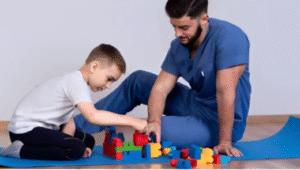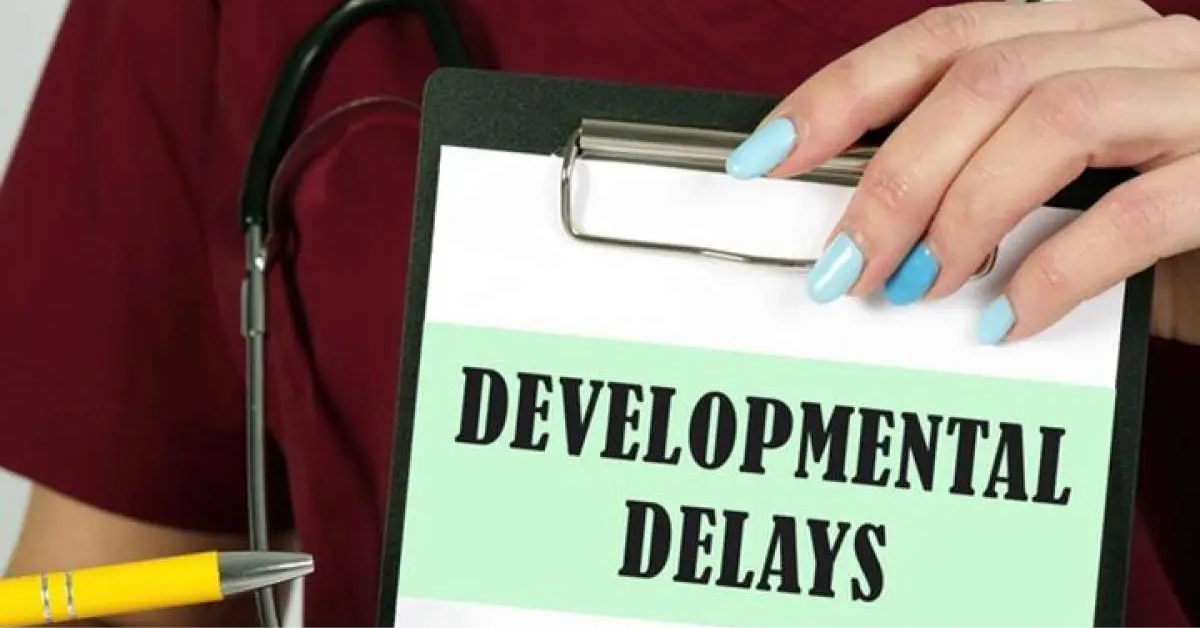Developmental Delay Occupational Therapy: Hope, Help & Real Progress
Developmental Delay Occupational Therapy
Developmental delay occupational therapy supports children who are behind in physical, emotional, or cognitive skills for their age . Through this type of therapy, children learn how to eat, play, dress, and even cope with the emotion better. It employs games, practical materials and techniques that develop skills gradually. When delay occupational therapy is administered to the children early, chances are that they learn to progress faster and become more independent even as they grow up.
What Is Developmental Delay?
Developmental delay implies that a child falls behind other children in achieving major milestones. These involve crawling, walking, talking, thinking, playing as well as social interaction. A delay can be in one area or in more. Certain delays are temporal in character and others can be long term and require assistance. Occupational therapy is beneficial in making the day-to-day difficulties a learning experience, thus, the child becomes strong, confident, and competent.

Signs of Developmental Delay Occupational therapy
The signs Development delay occupational therapy are plenty and no two children are the same. Seek out:
- Failure to crawl, walk or stand at the age wee expected to
- Poor grasp or use of toys
- The inability to feed themselves
- 2 years old few or no words
- Problems with playing with others
Becomes easily upset by lights and sounds or being touched These could be indications that a child may require assistance in relation to learning its management in the world. Occupational therapists conduct surveillance and evaluation and develop individual plans of each child.
Causes of Developmental Delay occupational therapy
Developmental delays occupational therapy are caused by myriads of reasons which it would be beneficial to understand in order to set proper course of treatment. Among the most frequent ones are:
- Premature Birth: A baby born at an early age may possess systems which are not yet developed. It might take longer to develop their muscles, their brains or their senses. This may mean that one is slow to sit, crawl or eat.
- Low Birth Weight: Infants that weigh very little tend to be weak in terms of tone, nutrition, and acquiring strength. Such problems may cause a poor growth of skills.
- Brain Injury or Trauma: Pre-natal and Post-natal injuries can cause the malfunctioning of the brain involving control of the body movement, coordination, and thinking. This can be the delivery complications or post-accident complications.
- Genetic or Chromosomal Disorders: There are genetic or chromosomal disorders such as Down syndrome, Fragile X syndrome and so on which influence development in predictable patterns. Occupational therapy enables such children to acquire skills in a manner to reflect their capacities.
- Prenatal Infections: Infant brain and body development in utero may be affected by such illnesses as rubella or cytomegalovirus. Such children are born with either their motor, vision or communication problems.
- Autism Spectrum Disorder (ASD): The behavior includes a difficulty in communication, senses, and socialization of children with autism. Such domains usually need a facilitated therapy to establish habits and operate in everyday life.
- Environmental Factors: Early development of a kid may be affected by lack of stimulation or inappropriate nutrition or subjection to some harmful substances (lead or alcohol). An anxiety house can also retard speech, play or emotional control.

Occupational Therapy in Developmental Delay: Development of Necessary Skills
Development Delay Occupational therapy assists the developmentally delayed children in enhancing their skills which are necessary in their daily activities. Such competencies are:
- Fine Motor Skills: Building the fine muscles of the hands and fingers to enhance putting away a writing speedily, buttoning up on a shirt and use of the cutlery.
- Hand-Eye Coordination: It enhances hand-eye coordination or the quality of avoiding misuse of hands relative to the suggestions of what is observed, which is essential to drawing, writing, and sportsmanship.
- Sensory Processing: Amplifying an enhanced skill set to process and respond to feelings, such as touch, sound, and body motion (i.e., to take control of themselves and their daily routines).
- Posture and Balance: The desire to have better posture and balance, which play an important role in ensuring one sits properly in a desk or walk without difficulties in a physical exercise.
- Self Care Skills: Helping the children to know how to conduct themselves everyday by taking care of themselves, dressing, brushing and feeding.
- Cognitive and Organizational Skills: Assisting the children in acquisition of problem solving as well as memory power, and a sense of organization necessary at school and at home.
- Social and Communication Skills: Enhancing communication and interacting skills as well as relations with peers and adults, having a social development.
Helping Children with Specialized Diagnoses, Including:
Develpment delay occupational therapy including,
- Autism Spectrum Disorder (ASD): It aids children integrate better into motor ability, sensory involvement, and societal skills so that they participate better in daily affairs.
- Attention Deficit Hyperactivity Disorder (ADHD): Enabling children to be focused, self-controlled and organized so that they can perform better in academic life and social life as well.
- Age Appropriate Delays: Helping children enroll and acquire age appropriate skills in motors, cognitive and communication skills in order to catch up with other children of their age.
- Dyspraxia (Developmental Coordination Disorder): Assisting children to enhance coordination ability, balance and fine motor skills such that writing and sport are addressed.
- Sensory Processing Disorder (SPD): Children with SPD can have trouble understanding and reacting to what they sense and can be unable to regulate themselves, or to feel comfortable in daily settings.
- Cerebral Palsy: Giving treatment that would maximize motor control, as well as improve posture and self-care to pave the way of having an independent person.
- Down Syndrome: here concentrating on building and reinforcing motor skills, social development and cognitive powers of the children with Down syndrome that helps them to reach developmental milestones.
- Handwriting Disorders: Offering ideas and activities of fine motor control, coordination and handwriting development.
What Does Developmental Delay Occupational Therapy Do?
Development Delay Occupational therapy assists students to function in daily life. It is used for those jobs:
- Dressing
- Eating with the spoon or fork
- Painting , cutting and writing
- Playing with class mates
- Skills to Manage behavior and emotions
Children learn through these skills in a fun, engaging and active way that is led by a licensed therapist. The purpose of homework is to enable tasks to be completed more easily and aid the child with becoming more independent.
Types of Developmental Delays Treated by OT
Development Delay occupational therapy assists the children struggling with various abilities. These include:
Fine Motor Delays: Difficulty in the use of hands and fingers to perform minor works such as writing, buttoning of clothes among others. OT generates strength and control through enjoyable resources such as crayons or zippers.
Gross motor delays: difficulties with large movements such as walking or jumping. OT will employ game/activities to develop equilibrium and coordination.
Cognitive Delays: Problems with thinking, planning or remembering. OT aids children to break down steps and learning a task through visuals and repetition.
Social Delays: Problems sharing with others, talking or playing with others. OT also teaches turn taking, expressions, and friendly behavior.
Sensory Processing Delays: Great responses to sound, light or textures. OT applies soothing games and objects to make the mind react in a more positive way.
Individual, playful schedules of getting children to develop at their own rates are established by the therapists

Is It Always Permanent Delay occupational therapy ?
No. Numerous delays get closed once the appropriate aid is provided at an early age. They may have long-term needs, however, when they undergo therapy, they get to know how to deal with it. In most cases, delay occupational therapy does not cure everything but makes life a little simpler, happier, more independent in a kid.
How Therapists Work with Children
Games, songs, toys and tools also help therapists to maintain enjoyable-effective sessions. Classes may be:
- Block constructions
- Drawing on or painting
- Dressing dolls
- Working on soft mats
The child does it by using special scissors or pencil grips which is not by listening. The goal is behind every activity.
What’s the Parent’s Role in Developmental delay occupational Therapy?
Key parents. They:
- Monitor the treatment periods
- Get skills to practice at home
- Provide practice every day
- Home celebrations
Therapists teach parents to bring the intervention of therapy into everyday life through celebrating little victories. So, as an illustration, a bath might be a time to learn how to balance or a snack might be a time to exercise grip strength.
Can Delay Occupational Therapy Happen at Home?
And the answer is yes, therapy can be performed at home or it can be held in clinics, still there is a possibility of conducting it even in schools. The advantage of this is that home-based therapy runs on the actual environment of the child. Parents are educated in transforming their kitchen, play room or the back yard to become growth zones.
What Happens in the First OT Session?
The initial session is none other but about learning.
The therapist:
- Observe the physical movement of your child and the way he/she plays
- Talks to you about the habits of your child
- Subtly challenges such capabilities as grasping, pointing or walking
- Begins to establish joyous objectives (such as gathering 5 blocks or taking food with a spoon) There are no needles, no machines. Smiling, playing and nursing.
Tools and Toys Used in developmental delay occupational therapy
Each one of the tools is shaped like a fun toy, and all of them are used to practice a skill:
- Weighed blankets: make children feel relaxed
- Textured balls: strengthen the fingers
- Scooters: enhancing your stability: Scooters are a good way to balance yourself better too.
- Pegboards: they assist in controlling fine muscles
- Visual schedules: develop routines Each child is provided with tools that suit him/her individually.
Do All Children with Delays Need OT?
Not always. Other delays get sorted out. Yet in the case of delays that interfere with eating, playing and day to day activities, OT can aid. Waiting is not the best action but starting early is. Short duration spells in therapy can transform the life of a child.
Can OT Help with Focus and Behavior?
Yes. OT improves:
- Sitting still
- Patience waiting-turns
- Following steps
- Finding ways of living with frustration, therapists educate children about how to relax, seek assistance, and make another attempt. The skills come in handy in school, at home as well as with friends.
Does Occupational Therapy Help with Sensory Issues?
Yes. Most of the children cannot deal with light, loud noise, or tags on clothes. Occupational therapy resorts to weak, slow tasks in order to make the brain comprehend these emotions. This is the reason why most parents consider occupational-therapy-help-with-sensory-processing-disorder when their child tends to react against simple things in a dramatic way.
When is It Time to Talk to The Doctor?
In case your child exhibits more than two symptoms of delay, consult your paediatrician.Don’t wait for school to catch it. Early therapy works best when started between 6 months and 3 years.
What Age Should Delay occupational therapy Start?
There are children who start delay occuaptioanl therapy at early ages as infants. The average age at which most kids start is between 1-4 years. The earlier the easier. In childhood, the growth of brains is rapid. It will save one the urge to struggle in school or in life, in the future.
Benefits of Development Delay Occupational Therapy
Children in OT show:
- Faster adaptation to everyday task
- More coordination and power
- More confidence
- Greater concentration and memory
- Happier playtimes It enables self-reliance. It relieves a lot of pressure in families. And that gives even more smiles.
How Long Does Therapy Take?
It really is based on the child. Some need only a few months. Some will need 1-2 years. The time is dependent on progress not a set schedule. Kids grow with their own pace.

Are There Other Therapies Used with OT?
Yes. The children could also benefit on:
- PT or physical therapy
- Language therapy and speech therapy
- Behavioral therapy
- Special education support
The services usually collaborate in the total development of the child.
Final Thought: Little Steps Lead to Big Wins
Development delay Occupational therapy is not one that is caught up in a day. It is each small skill being unlocked. Therapy develops those skills that are the results of independence: starting with wearing socks, progressing to playing a game. Children achieve lifetime progress when they work as together with their families and therapists.
Short FAQs About Developmental Delay Occupational Therapy
Q1: What is the minimum age of a child to engage inDevelopment delay Occupational Therapy?
A great number of children begin at the age of 1-3. Faster is better sooner.
Q2: Does Occupational Therapy assist in eating issues?
Yes, OT is to learn how to eat better using hands and mouth muscles.
Q3 How long does therapy last?
It is preferable but many children stay months or a year.
Q4: Is Occupational Therapy at home possible?
That is correct, therapists can provide parents with simple activities at home.
Q5: Is my child going to like Occupational Therapy?
Yes! It is like playing and it develops critical life values.

